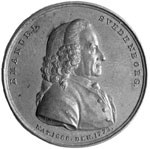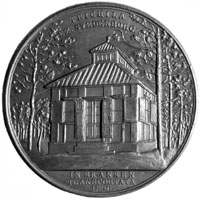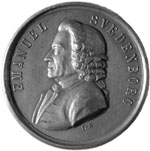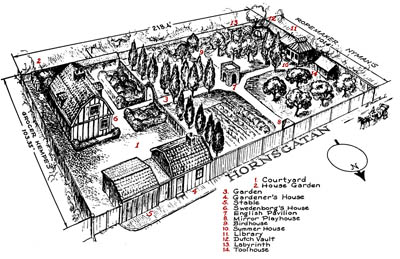An 1896 Swedenborg Medal Commemorates the Moving of His "Summerhouse"
Ed
Gyllenhaal
Glencairn
Museum News 24.2 (2002): 4–6.

Above: The Glencairn Museum/Bryn Athyn College course abroad "Swedish Roots: The Revelator and His Revelation" visited Swedenborg's summerhouse in June, 1998. Participants were allowed to go inside and hear music played on Swedenborg's original chamber organ.
Sometimes the smallest objects in a museum tell the most interesting stories. Such is the case with two Swedish medals recently donated to Glencairn Museum by Herman and Monica Gyllenhaal, cousins of mine who live just outside of Stockholm. These medals were struck in 1896 to commemorate the moving of Swedenborg's "summerhouse" (Swedish lusthus) from Hornsgatan, the street in Stockholm where he had lived, to its present location at Skansen, a few miles away on the island of Djurgården. Skansen, the world's first open-air museum, was founded in 1891 by Arthur Hazelius. Its purpose was to show visitors how Swedes had lived in earlier times and to gather together historic buildings typical of various regions. To this day it remains one of Stockholm's most popular tourist destinations.
The summerhouse medals were commissioned by The Nordic Museum (Nordiska Museet), which at the time was administered jointly with Skansen.1 They were originally struck in silver and bronze; the Glencairn examples are in bronze and aluminum. The reverse features an attractive representation of Swedenborg's summerhouse surrounded by trees, inscribed Trichila Em. Svedenborg in Skansen transportata 1896 ("Summerhouse of Emanuel Swedenborg, moved to Skansen, 1896").
The obverse of the two Glencairn examples feature two different portraits of Swedenborg (see above). One of these portraits (in aluminum, 05.CO.589) is identical to the one found on an earlier Swedenborg medal, struck in honor of Swedenborg in 1858 by The Swedish Academy (Svenska Akademien, an institution created to advance Swedish language and literature). It bears the initials of Lea Ahlborn (born Lundgren, 1826–1897), who served for 44 years as the royal coin and medal engraver. She is remembered as the first female civil servant in Sweden's history.
The Swedenborg portrait found on the silver and bronze examples of the Skansen medal, however, was not engraved by Lea Ahlborn. It had been engraved much earlier, in 1852, by Lea's brother Pehr Henrik Lundgren (1824–1855). Pehr had preceded her in the position of royal coin and medal engraver. This, the first of the three 19th century medals struck in honor of Swedenborg, had been commissioned by The Royal Swedish Academy of Sciences (Kungl. Vetenskapsakademien).
As mentioned above, while the summerhouse medal was originally struck in silver and bronze, one of the Glencairn examples is made of aluminum. This probably represents a second edition of the medal, most likely a restrike by The Nordic Museum. They may have used the 1858 Swedenborg portrait intentionally in order to produce a medal with both sides made by Lea Ahlborn. Alternately, the use of this version of the portrait may have been accidental—it was not unusual for dies to get mixed up at the Royal Mint.
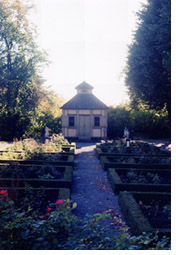 Exactly
what did Swedenborg use his summerhouse for? According to Carl Robsahm, a bank
treasurer in Stockholm who knew Swedenborg during the later part of his life,
the summerhouse was built "for the sake of the public that came to see the old
gentleman, generally out of curiosity."2 However,
the small windows and enclosed appearance of the building would have made it an
unlikely place for entertaining groups of people. On the contrary,
Swedenborg probably intended the structure as a garden retreat where he could
retire to work in privacy. The Rev. Nicholas Collin of Philadelphia visited Swedenborg
in 1766, and concluded that the summerhouse was "a kind of temple, to which he
often retired for contemplation; for which its peculiar structure, and dim religious
light were suitable."3 In any
case, Swedenborg must have used it often, for one visitor, the librarian C.C.
Gjörwell, mistakenly believed that he lived in it!4
Exactly
what did Swedenborg use his summerhouse for? According to Carl Robsahm, a bank
treasurer in Stockholm who knew Swedenborg during the later part of his life,
the summerhouse was built "for the sake of the public that came to see the old
gentleman, generally out of curiosity."2 However,
the small windows and enclosed appearance of the building would have made it an
unlikely place for entertaining groups of people. On the contrary,
Swedenborg probably intended the structure as a garden retreat where he could
retire to work in privacy. The Rev. Nicholas Collin of Philadelphia visited Swedenborg
in 1766, and concluded that the summerhouse was "a kind of temple, to which he
often retired for contemplation; for which its peculiar structure, and dim religious
light were suitable."3 In any
case, Swedenborg must have used it often, for one visitor, the librarian C.C.
Gjörwell, mistakenly believed that he lived in it!4
It was the custom in the Stockholm of Swedenborg's day to erect summerhouses near larger residences, usually at the end of a path leading from the main house through the garden (see line drawing below). Robsahm writes that Swedenborg's summerhouse was connected to two other small structures on either side: to the north was a shed for storing garden tools, and to the south was Swedenborg's "handsome library." And according to a description of Swedenborg's property published soon after his death in 1772, the summerhouse was "painted yellow, and in the interior it [was] hung with pretty tapestry."5
Reconstruction
of Swedenborg's property by Donald Moorhead (1953).
Click on image
for a larger version.
By the time it was moved to Skansen in 1896, the summerhouse was the last remaining building from Swedenborg's property. It had remained in its original location on Hornsgatan for 124 years. Although it had gradually fallen into disrepair, it was by no means forgotten by the residents of this part of Stockholm. In fact, according to a 1981 book about summerhouses in Stockholm, "there is perhaps no other summerhouse that has as many stories told about it as this one."6
As early as 1848, the Swedish writer C.A. Wetterbergh visited the summerhouse. He wrote that this was where Swedenborg "had most of his visions." An old woman familiar with the place told him that "it was here . . . from the mirror, that the Assessor (Swedenborg) saw visions, as if floating towards him."7 By the 1870s the garden had become a place for trash collection, and the summerhouse was rented out to various people, including a poor family, as living space. One writer even reported that a gang of thieves used it as their hideout.8 In 1879 a newspaper article lamented that the structure was falling into serious disrepair, and was being used as a junk shed for Stockholm's oil lighting company. The owner of the summerhouse wrote back to the newspaper to suggest that the government should pay to repair the house: "none of the hundreds of foreigners, mostly Englishmen and Americans, that yearly visit the site, leave without expressing their amazement for the government's indifferent attitude toward such a historical place."9
But the saddest chapter in the history of the summerhouse came toward the very end of the 19th century. Last fall, while doing research for this article with my cousin Herman at the Skansen archives, we came across an old photograph of a man standing next to the summerhouse, a sign above the door reading "Entré 25 öre" ("entrance 25 cents," about a dollar in today's money). The full meaning of this photo did not become apparent until several months later, when I received a photo of the interior from the Stockholm City Museum. It seems that a stone carver named Richard Sundell had covered the interior from floor to ceiling with black fabric, decorating it with silver stars. In the middle of the room there were several steps leading up to a coffin. Plants and flowers were spread around, and lying inside the coffin was a figure of Swedenborg! At first he charged an admission of 10 öre to enter and see this spectacle, but later he increased the fee to 25 öre.10
It was therefore a very welcome development when Arthur Hazelius, the founder of Skansen and son of two devoted readers of the Writings, decided to move the summerhouse to its present location. An 1895 letter to Hazelius from the owner, a Mrs. H. Ahlström, reveals that she offered to sell the summerhouse to him for 1500 kronor.11 Other records show that the price was negotiated down to 500 kronor, which was paid with the help of two Swedish New Churchmen. The summerhouse was moved and the medal struck in 1896, and Swedenborg's original chamber organ, which had been in the collection of The Nordic Museum, was moved inside.
In the 1980s both the summerhouse and the organ underwent restoration. It is now possible to see the summerhouse while enjoying a concert with period organ music in the midst of a garden, a garden created to remind us of the one Swedenborg himself created so long ago.
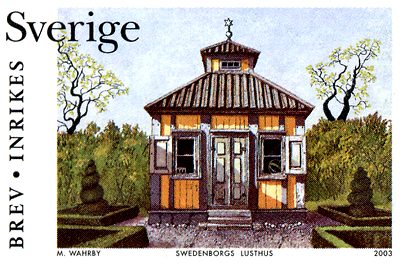
This stamp of Swedenborg's summerhouse was issued by the Swedish Postal Service in 2003. It was part of a series of stamps commemorating historic Swedish summerhouses. © Posten Sweden
Footnotes top
1 Information about the "summerhouse medal" and other Swedenborg medals can be found in Bror Edvald Hyckert's Minnespenningar öfver enskilda svenska män och kvinnor (Stockholm: Kungliga boktryckeriet P. A. Norstedt söner, 1905).
2 "Robsahm's Memoirs of Swedenborg," in Documents concerning the Life and Character of Emanuel Swedenborg (Vol. I), comp. and ed. R.L. Tafel (London: Swedenborg Society, 1875), p. 32.
3 "Testimony of the Rev. Nicholas Collin, Rector of the Swedish Church in Philadelphia," in Documents concerning the Life and Character of Emanuel Swedenborg (Vol. II, part 1), comp. and ed. R.L. Tafel (London: Swedenborg Society, 1877), p. 423.
4 "Librarian Gjörwell's Testimony," in Documents concerning the Life and Character of Emanuel Swedenborg (Vol. II, part 1), comp. and ed. R.L. Tafel (London: Swedenborg Society, 1877), p. 402.
5 "Description of the Property of the Late Assessor Emanuel Swedenborg, Situated in Södermalm," in Documents concerning the Life and Character of Emanuel Swedenborg (Vol. I), comp. and ed. R.L. Tafel (London: Swedenborg Society, 1875), p. 392.
6 Ingvar Storm, Lusthus i Stockholm (Summerhouses in Stockholm) (Askild & Kärnekull: 1981), p. 72.
7, 8, 9, 10 Henrik Alm, "Emanuel Swedenborgs Hus och Trädgård" (Emanuel Swedenborg's House and Garden), in Samfundet Sankt Eriks Årsbok 1938 (Yearbook of the Association of Saint Erik, 1938), (Stockholm: Kgl. Boktr. P.A. Norstedt & Söner, 1938), p. 169–170.
11 H. Ahlström to A. Hazelius: Stockholm, 10/14/1895. Skansen archives, Stockholm.
